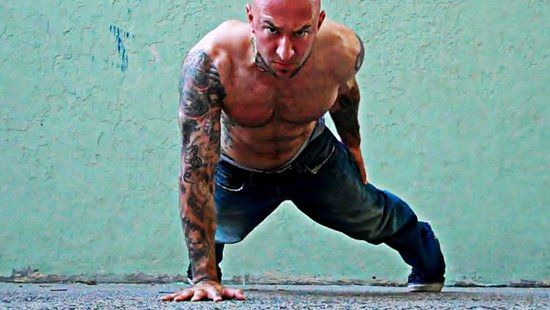
I love body weight exercises. I think they should be the basis of any training program. Body weight movements can be used for warming up, for cooling down, for flexibility and mobility. Then, once you learn these movement patterns, they can be progressed to truly test one’s individual strength. Things like pistol squats, pull-ups, handstand push-ups and one-arm push-ups are incredible exercises, which is one of the reasons I gravitated towards Convict Conditioning. This book has been instrumental in bringing my skill set to the next level. I use it to train myself as well as my clients. It has helped me clearly structure a periodized workout plan for my clients with clear goals and progressions.
When I design my training programs, I train opposing muscles groups or movement patterns. For every action – there is an equal and opposite reaction. For example, we all know that the push up is a fantastic upper body strength exercise – but when overused, it can cause some issues. The big muscle groups like the upper pectorals; shoulder and the internal rotators of the arm and shoulder can become shorter and tighter than the external rotators and scapula retractors. This tightness can possibly cause a forward rounding posture and possible neck and shoulder injuries. So to make sure I don’t cause these possible issues, I always have an opposite movement paired with the exercise, in this case, the body row. This is my push/pull relationship method of training.
The body row is the sister exercise to the push up, however, it is much less utilized. It also incorporates almost all the same muscle groups as the push up. The exception is that the prime movers are the back of the body (posterior chain) as opposed to the front (anterior chain) of the body. Most of the attention goes to the Pull Up as the ultimate body weight back exercise, which is of course an awesome exercise, but until my clients are strong enough to do them correctly, the Body Row rules the roost!
So, what is that missing link you may ask? It’s the Body Row. Actually, since we are talking about the One-Arm Push Up, it’s the One-Arm Body Row!
In fact, as I progress up the ten steps in Convict Conditioning Push Up Series, I progress up my own steps to a one-arm body row.
In Convict Conditioning, the horizontal pull is what I call a body row. I use the Lebert Equalizers for my horizontal pulls because I can add some great variety to the pulls as well as bring them with me to where ever I want to train, inside or outside. Always having a place to do a pull up is sometimes an issue. So, if I am outside and want to add in some pulls, I can.
The Body Row is similar to Convict Conditioning’s Pull Up Series Step Two, but with a different tool. Here is the point where I branch off from the Pull Up Series and add a few alternative steps with the Equalizers that translate to a better one-arm push up.
I will not go into great detail about each body row movement because I am sure if you are following Convict Conditioning, you get the main points on proper form. I will point out the basics though, which are pretty straightforward. When you get into your starting position with the Equalizers (EQ), dig your heels into the ground and fire your glutes to keep your hips locked and aligned. Grab the black grips with a firm hold to fire the forearms. Keep a neutral spine as you pull yourself off the ground. When you progress to the single arm body rows, it is much like a single arm kettle bell swing in that your body will want to rotate on you. Do your best to keep your shoulders parallel to the floor. Your core will get quite a workout here too!
Convict Conditioning Push Up Steps with correlating Body Row Movements:
Step 4 – Half Body Row – Mirrors the Half Push Up (the ball under the glutes is to help cue you to keep your hips up)


Step 5 – Full Body Row – Mirrors Full Push Up


Step 6 –Single EQ Chin up – Mirrors Close Push Ups


Step 7 –Single Leg EQ Body Row – Mirrors the Uneven Push Up


Step 8 – One Arm Half EQ Body Row – Mirrors the One Arm Half Push Up


Step 9 – One Arm EQ Body Row – Mirrors the One Arm Push Up


So there you have it, a push/pull relationship that not only enhances your one-arm push up but also increase your overall body weight strength.
Todd M. Cambio, CSCS, HKC is the owner of Precision Fitness in Westerly, RI. He is a strength and conditioning coach that specializes in sports performance and obstacle course race training. Todd is a Certified Strength and Conditioning Specialist, a Spartan Group X Obstacle Course Coach, a published author and Master Body Weight Trainer & Presenter for Lebert Fitness. See what Todd is up to by visiting www.ToddCambio.com.
